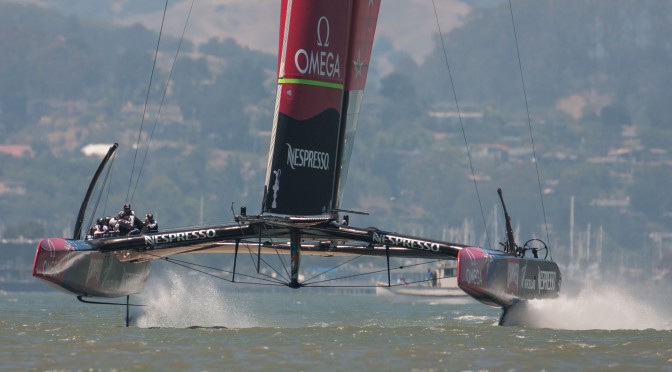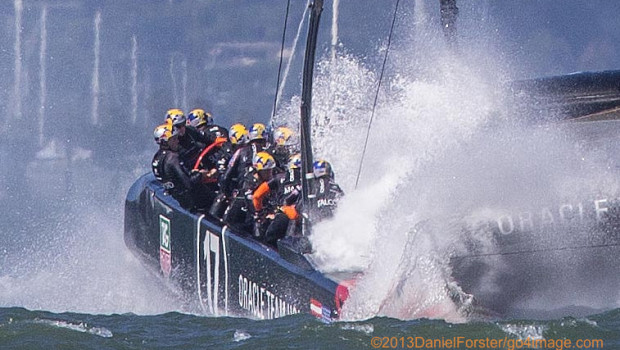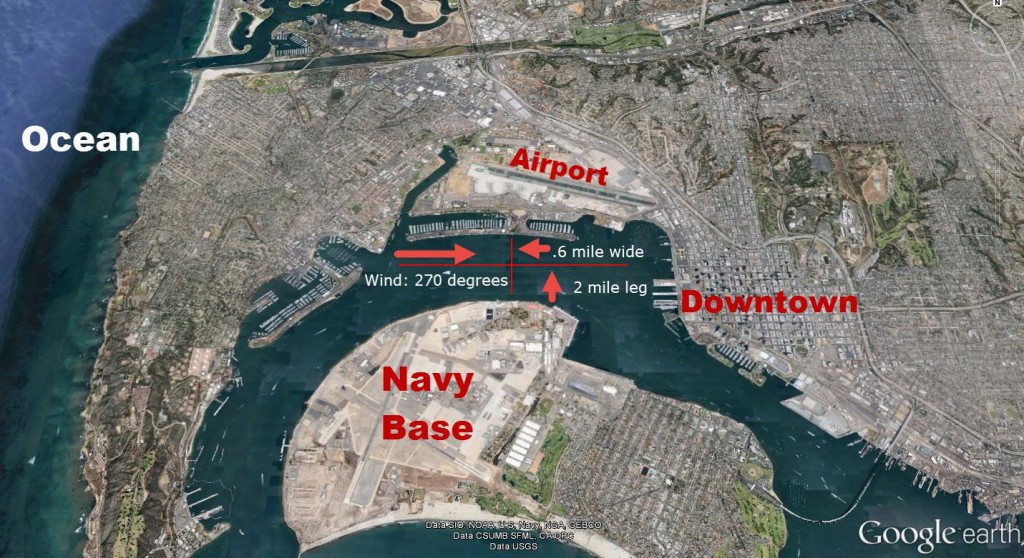
The New America’s Cup Cat
The next generation will look much like this 2013 generation challenger from New Zealand, but they’re a new breed
By Kimball Livingston Posted April 13, 2014
Gino Morrelli believes the next generation of America’s Cup catamarans will revolutionize upwind tactics. He foresees the boats foiling through tacks without slowing down, and if there is no price for tacking, that’s a new calculus, isn’t it? A new game.
Smaller, faster, safer. It’s quite a package that Morrelli is talking about, and he knows a bit. His firm of Morrelli & Melvin wrote the design rule for what we will call, for now, the AC62. That is, ten feet shorter than the AC72s of 2013 and shrunk appropriately in other dimensions as well. Add-in some one-design components, factor-in the fact that a lot of the design possibilities have already been explored—we know what the next generation will look like—and you have a boat that is cheaper to design and cheaper to build, even with amped-up technology. His partner Pete Melvin has been hard on the case.
At which point Morrelli adds the ultimate qualifier, “We can lower the cost to entry, but we can’t make it cheaper to win the America’s Cup.”
Write this on the board twenty-five times: An America’s Cup team will always spend whatever it can get.
I shared billing with Gino over the weekend for a program at Strictly Sail Pacific, which opened my window onto what’s coming next, with a little caution tape on the windowsill: “We finished our job about four weeks ago,” Morrelli told the audience. “In our last iteration, the boat was 62 feet, but now we’ve handed it over to Oracle and Russell and the boys to fuss it out with the Challenger of Record and Iain Murray. That is, the Aussies from Hamilton Island Yacht Club. Between them, a lot can happen. We’re now out of the loop, but something’s cooking . . . At some point they have to pull the trigger and publish the design rule and let people start working on the new boats, even if they don’t decide the venue until deep in the process.”
How can you design the boat if you don’t know the venue? Or if, as Larry Ellison once suggested, there could be more than one venue? Good question. Here we go—
Gino again: “One thing that was possible under the AC72 rule, but now is mandated, is a wing design that can be over-rotated to a negative angle of attack. You would do this at the top of the wing, so that instead of pushing the boat over, it’s actually pulling the boat up. Theoretically, if you’re bearing away around the weather mark in 30 knots, you can crank the wing inside out to get positive righting moment. You get a safer turn. The downside is that you’re inducing drag, which slows you down, so you’re going to have to learn how to actually do this. But it’s one way to build a big rig that will perform in San Diego but survive San Francisco.
“There are provisions in the new class rule to allow different wing sizes and jib sizes, but the ability to over-rotate the wing gives us a tool for sailing in a wide wind range with one wing.”
Early in the development of the original design rule for the AC72s, there were no restrictions on foiling surfaces. Restrictions were added at the insistence of the then-Challenger of Record, but we know now that the result was merely to make the boats trickier to design and less safe for the sailors.
This time out, Gino says, “We’ve got everybody to agree to take the brakes off foiling. The boats will foil by design. We’ll be able to actively change the angle of the rudder posts to adjust the angle of attack of the T-foils on the rudders—in 2013 we could make changes between races, not during a race—and the T-foils will be symmetrical, and bigger. This is part of what brings us to foiling tacks. You’ll have more chance to use low angles of attack to give you the highest glide speed through the tack. We’ll see who can glide to weather the farthest.”
This likewise opens new imaginings in what it means to attack, attack, attack.
On the safety side, there is now a minimum bow volume, for buoyancy if the boat augurs in. “New Zealand had the biggest bows in the fleet in 2014,” Gino said. “They stuffed it in that one race and survived. After the fact we sat down with the Oracle Racing guys to analyze the video of that incident, and we determined that, if Oracle had done the same thing, they would have been upside down. So, the new bow dimensions are much closer to the NZ spec than to the Oracle spec.”

Photo by Daniel Forster
You might recall, ETNZ took that serious nose dive in an early race, and Oracle did this less-radical face plant on the reach to the first mark in the deciding, final race, which could have come out rather differently. As seen through the lens of Daniel Forster . . .
With hulls now functioning as components of a foil-delivery system, the extra bow volume builds a safety margin with no meaningful downside. A little more carbon, a little more weight, a little more windage, but equalized through the fleet. Where Oracle had a safety advantage over the Emirates Team New Zealand boat was in its protective cockpits. When ETNZ stuffed it, bodies were flung forward against each other—there weren’t enough grab points—and as the boat sailed on, there were fewer crew on deck. The “AC62? mandates cockpits.
For an easy point of cost saving, “That crazy aerodynamic structure on the underside of Oracle, fairing-in the dolphin striker, will be restricted. It represented a lot of research, a lot of engineering and a lot of carbon. By going one-design on those components, we’re saving the teams a lot of development, so now we get calls from the CFD [Computational Fluid Dynamics] engineers saying, ‘Hey, what about our lunch?’ Then there’s the grinders union . . .”
The big picture view of the 2013 America’s Cup is that Oracle Racing built a faster boat—more aerodynamic, twistier, harder to sail—and learned how to sail it just in time. Mastering upwind foiling was the key, and one key to that was grinding style. You probably know the old joke, “You just keep grinding and if I need any sheet I’ll take it.” Well, launching the comeback, that’s exactly what was going on aboard Oracle. Trimmer Kyle Langford needed instant response to keep the boat on knife’s edge. Asking the boys to pump oil to generate hydraulic pressure for trimming built in a delay that just didn’t cut it. So the grinders would grind all the way. No stored energy was allowed under the AC72 rule, but the new rule as written by Morrelli & Melvin, in consultation with Oracle Racing’s Russell Coutts and Ian Burns, for example, will permit a component of stored energy. The grinders may still be grinding steadily, but not frantically. At least, according to the numbers. As one result, the crew has been reduced to the tune of two grinders. That’s two less jobs on the payroll per boat, and two less jobs per boat in the America’s Cup Industry.
Gino Morrelli has a laid back Southern California style, and he comes by it honestly. The whole team at Morrelli & Melvin Design and Engineering has been known to shove work and hit the beach when the surf is up. Morrelli describes himself as, “A longboard kind of guy.” It’s not far from their Newport Beach offices to the sand. Obviously, they also crank out the work. M&M also developed the design rule for the AC72s, and they were the principal authors of the design of Emirates Team New Zealand. They’ve been part of the America’s Cup every time multihulls have been in the game: 1988, 2010 and on. They’re also part of cutting edge multihull racing at every level from A-cats up, and cruising cats from the Hobie Wave to Gunboats. And when I want to impress the nieces and nephews, I just tell’em, yep, I know the folks who designed the Jungle Cruise boats for Disneyland. Those are their only monohulls, I believe, unless you count stand up paddleboards.

The Q&A rambled a bit. Naturally, a Bay Area audience wanted to know if the 2017 match will be sailed here. I voiced my stubborn optimism that it will, simply because that’s what ought to happen.
Someone asked why Artemis Racing still has its base in Alameda, and their 45 is sometimes seen on the bay. Gino responded that, well, everybody has to be someplace, “and I think they’re betting that the next races will be here.”
Another circuit in AC45s? Here’s Gino: “The 45s attract a lot of interest from the start-up teams. It’s a way to bring in sponsors and show the racing to a home audience. On the upside, it’s pretty easy to convert an AC45 to a foiler. On the downside, the logistics are completely nuts. The circuit was a giant loss leader. No way could it stand on its own. Larry wrote the check for the whole show the last time, but I don’t know how interested he might be in helping those start-up teams get a foothold. He’s already spent so many hundreds of millions on this. I figure the AC45s are a tier 3 decision right now.”
What’s the status of Morrelli & Melvin vis a vis AC35? “We’re free agents again. We’ve been contacted by a number of the guys, but everybody’s waiting for the Class Rule and the Protocol.”
More challengers next time? “Sixish. The Aussies are in, and Artemis. Luna Rossa. Probably the Kiwis, and the French are trying hard and so is Britain, with Ben Ainslie. The design box is tighter and smaller, but I guarantee you there’s enough room inside the box that someone’s going to come up with a faster boat than somebody else.”





